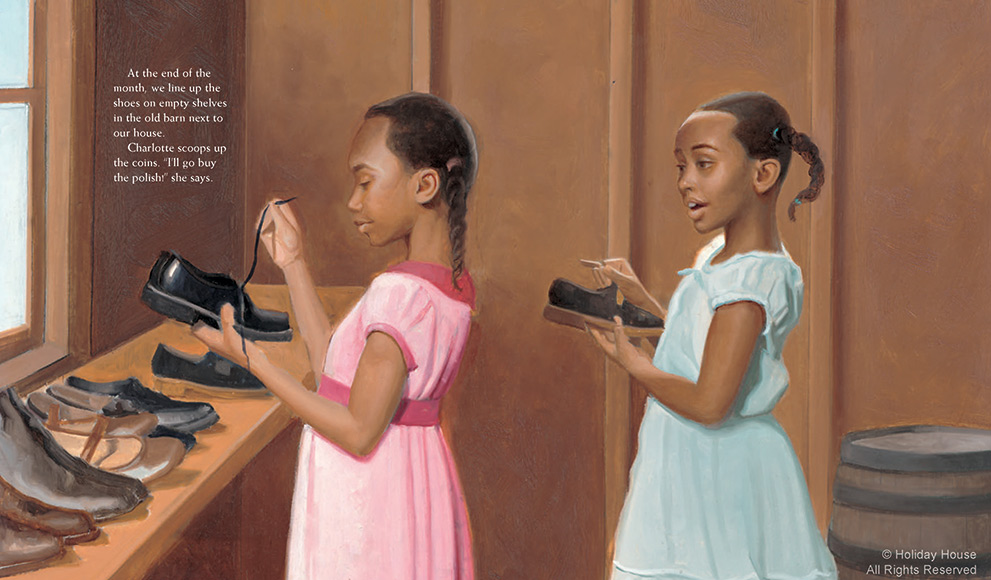"New Shoes" Tells Story of Discrimination and Resistance for Young Children

Holiday House, a long established New York publisher of books for children, is celebrating Black History Month with the publication of Susan Lynn Meyer's picture book, New Shoes. The story, set in the 1950s, educates young readers about the discrimination African-Americans faced before the civil rights movement began.
In the story, illustrated by the acclaimed Eric Velasquez, Ella Mae goes to a local store with her mother to buy her first pair of new shoes. Ella Mae watches with anticipation as a white girl models several selections. Yet when Ella Mae asks the clerk for help, she is told that blacks can buy the merchandise but are forbidden to try anything on.
Ella Mae’s mother purchases a pair of shoes, explains the injustice to her daughter, and encourages her to think about how pretty she will look in the new shoes. Ella Mae, embarrassed and dejected, decides to fight back. She and her cousin Charlotte collect used shoes from friends and neighbors, which the two spend hours wiping, washing, and polishing. The girls then have their own shoe sale, giving other members of the African-American community a place to buy shoes where they can be treated fairly and “try on all the shoes they want.”
While New Shoes is a fictional story, Meyer says the girls’ solution is a good example of the “subtle acts of resistance and rebellion” that blossomed as African-Americans dealt with unfair statutes that dictated nearly every aspect of their lives, including where—and if—they could purchase basic necessities or a meal, or have a drink of water.
Meyer, professor of English, has published literary criticism, one other picture book, and a young-adult novel, Black Radishes, which won the Sydney Taylor silver medal and was named a Bank Street Best Children’s Book of the Year.
The impetus to write a children’s book about the African-American experience came several years ago, she says, when her now-teenage daughter was in kindergarten. Meyer volunteered in her daughter’s classroom every Friday, and would bring in picture books and read them to the children. “For February, Black History Month, I wanted to read picture books with black protagonists,” she recalls. “I found a few—and of course I already knew about The Snowy Day by Ezra Jack Keats and Corduroy by Don Freeman—but I had a hard time finding enough to read.”
Meyer asked her colleague Margaret Cezair-Thompson, senior lecturer in English whose interests include African and Caribbean literature as well as creative writing and who had a 4-year-old son at the time, what books she could recommend. Cezair-Thompson suggested some good titles, Meyer says, “but still, even now, there definitely aren’t enough good picture books with black protagonists. Some of my favorites now are Jacqueline Woodson’s The Other Side and My Best Friend by Mary Ann Rodman.”
As a scholar, Meyer has long been interested in the relationship between literature and history. The inspiration for New Shoes came, not surprisingly, when she “first read about this phenomenon—that black people weren’t allowed to try on shoes or clothes or hats in the Jim Crow era. I probably talked about it at dinner that night. So my daughter feels as if she has always known about it.”
Yet when Meyer spoke with socially conscious white adults, she was surprised to learn that many didn’t know about the practice, even those who had grown up during the Jim Crow era. “They had no idea,” she says. “But black people I have talked to, even ones too young to remember it themselves, well, lots of them certainly do know about it. It didn’t just happen in the South either—it was pervasive. It happened all over the U.S.”
As a white woman writing about African-American characters, Meyer felt it was crucial to talk with black friends who had had similar experiences and to get their feedback on drafts of New Shoes as it was taking shape. Their comments influenced the development of the story, including the mother’s reaction after Ella Mae’s embarrassment in the store.
“I don’t write with a moral agenda in mind, or to convey a particular message,” Meyer explains. “But I do want readers of New Shoes, readers of all ages, to know about this lesser-known aspect of Jim Crow. When I found out about this—blacks not being allowed to try on shoes—it really hit home for me, and I mused a lot about what that would have felt like, especially for a child encountering it for the first time. Imagining and wondering led me to this story.”
Meyer, who is currently on sabbatical and writing a novel, believes “that the arts (including, of course, literature) have a huge and incalculable effect on the way people think and feel,” she says. “Maybe stories and novels have that effect most of all, because in order to experience them deeply, the reader takes on the experience and the perspective of the main character.”
Yet Meyer is quick to acknowledge that stories alone did not advance the cause of civil rights: “Only organized protest, suffering, and sacrifice by a lot of people, along with lots of media attention, did that.”
Text copyright © 2015 by Susan Lynn Meyer
Illustrations © 2015 by Eric Velasquez
Used by permission of Holiday House.
